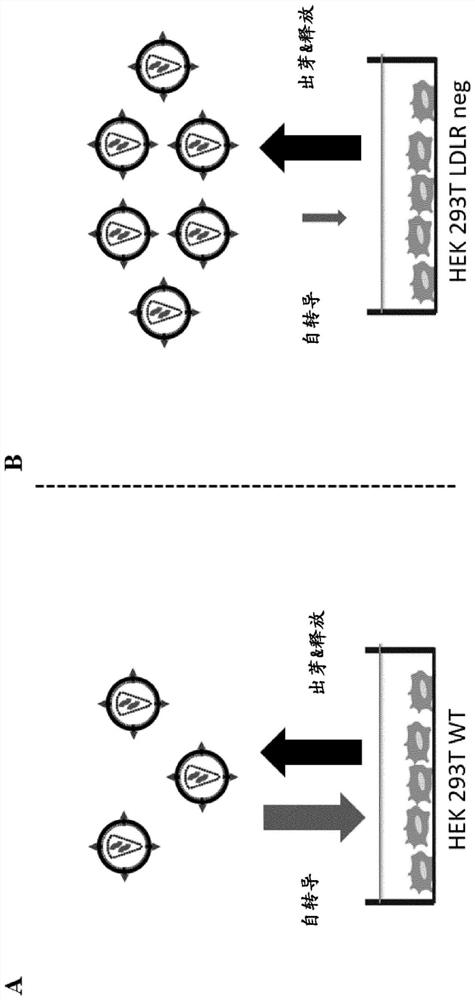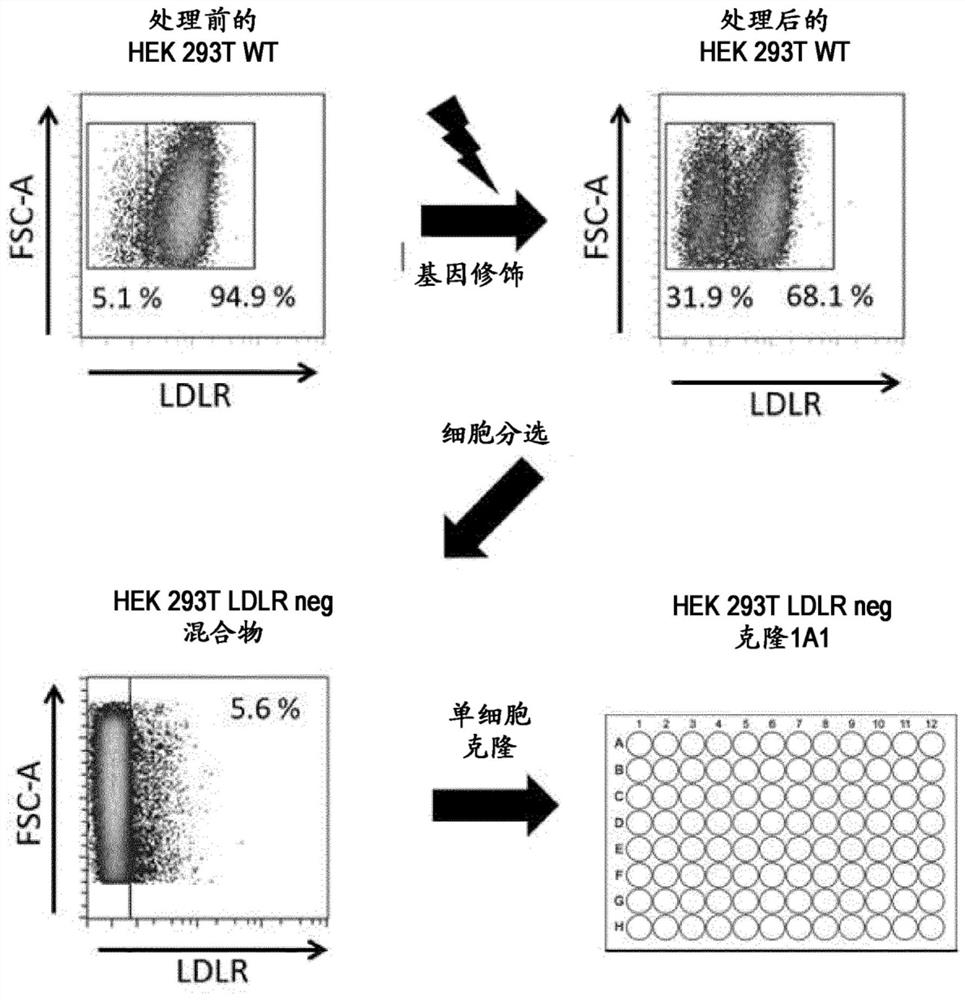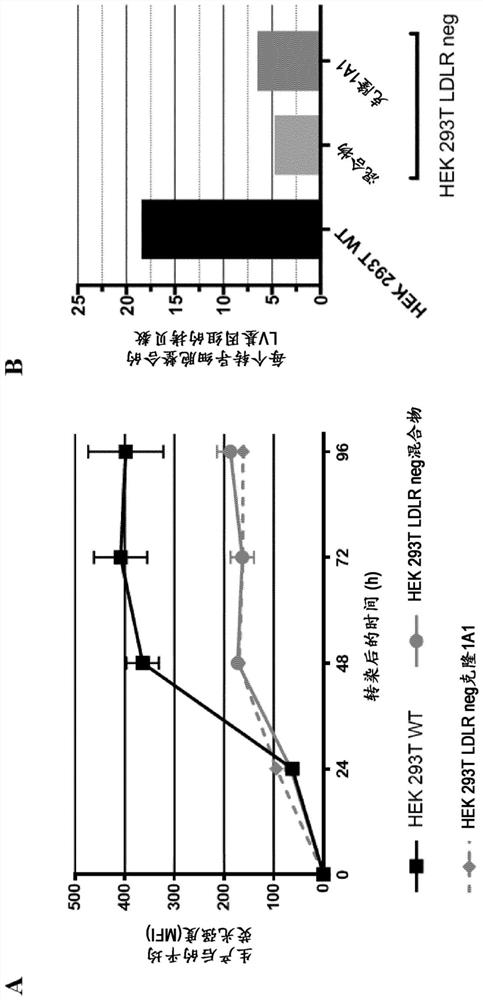Ldlr negative packaging cell line for the production of vsv-g pseudotyped retroviral vector particles or virus particles thereof
A technology for packaging cell lines and retroviruses, applied in the field of producing VSV-G pseudotyped retrovirus vector particles or vector-like particles, which can solve problems such as exhaustion
- Summary
- Abstract
- Description
- Claims
- Application Information
AI Technical Summary
Problems solved by technology
Method used
Image
Examples
Embodiment approach
[0095] In one embodiment of the present invention, the LDLR gene of the HEK 293T packaging cell line has been knocked out by methods well known in the art, thereby generating an LDLR-negative HEK 293T packaging cell line (HEK 293T K.O.). The HEK293T K.O. packaging cell line is made with a psi-negative lentiviral expression vector encoding the gag / pol gene, a psi-negative lentiviral expression vector encoding the rev gene, a psi-positive lentiviral expression vector encoding a transgene, and a psi-negative lentiviral expression encoding VSV-G Vectors are co-transfected, and the transgene may encode, for example, a chimeric antigen receptor. The HEK 293T K.O. packaging cell line produces high rates of VSV-G pseudotyped lentiviral vector particles carrying the genetic information of a transgene (eg, chimeric antigen receptor). These particles can be used to transduce stem cells or immune cells, such as T cells or NK cells, designed to express a transgene (eg, a chimeric antigen r...
Embodiment 1
[0142] Example 1: Production of VSV-G pseudotyped lentiviral vector
[0143] VSV-G pseudotyped lentiviral vectors were generated by transient transfection of HEK 293T cells. On the day of transfection, HEK 293T cells were seeded at 1.0E06 cells / mL in 25 mL of serum-free cell culture medium in 125 mL of Shakerflask (185 rpm) with plasmids encoding VSV-G, gag / pol, rev and encoding GFP (Complete plasmid system) or psi-positive transfer vector plasmid of therapeutically relevant CD20-CAR for transfection. 24 h after transfection, 10 mM sodium butyrate (Sigma-Aldrich, catalog number: 3034 10-5004) was added. 48 h after transfection, the lentiviral supernatant was harvested by centrifugation at 200 x g to remove cell debris, aliquoted and stored at -80°C for subsequent use.
[0144]In order to transfect cell lines stably expressing VSV-G, HEK 293T cells were seeded in DMEM / 10% FCS / 0.8 μg / mL puromycin (Biowest, catalog number 12362; Biochrom, Cat. No. S0415; Gibco, Cat. No. A111...
Embodiment 2
[0145] Example 2: Titration of VSV-G pseudotyped lentiviral vectors on HT1080
[0146] For titration of lentiviral vectors, HT1080 cells cultured in DMEM / 10% FCS were seeded at 1.1E05 cells / well in 24-well plates one day before transduction. On the day of transduction, determine the cell number, wash the cells with DMEM, and use [8 μg / mL] (Sigma Aldrich, catalog number: H9268-5G) serially diluted particles encoding GFP or CD20-CAR in DMEM were transduced. 72 h after transduction, the transduction efficiency was determined by determining the ratio of GFP or CD20-CAR positive cells by flow cytometry. The ratio of GFP positive cells, the dilution factor, and the volume of lentiviral vector applied were used to calculate the titer of the lentiviral vector (ie, transducing units per volume (TU / ml)).
PUM
| Property | Measurement | Unit |
|---|---|---|
| diameter | aaaaa | aaaaa |
Abstract
Description
Claims
Application Information
 Login to View More
Login to View More - R&D
- Intellectual Property
- Life Sciences
- Materials
- Tech Scout
- Unparalleled Data Quality
- Higher Quality Content
- 60% Fewer Hallucinations
Browse by: Latest US Patents, China's latest patents, Technical Efficacy Thesaurus, Application Domain, Technology Topic, Popular Technical Reports.
© 2025 PatSnap. All rights reserved.Legal|Privacy policy|Modern Slavery Act Transparency Statement|Sitemap|About US| Contact US: help@patsnap.com



